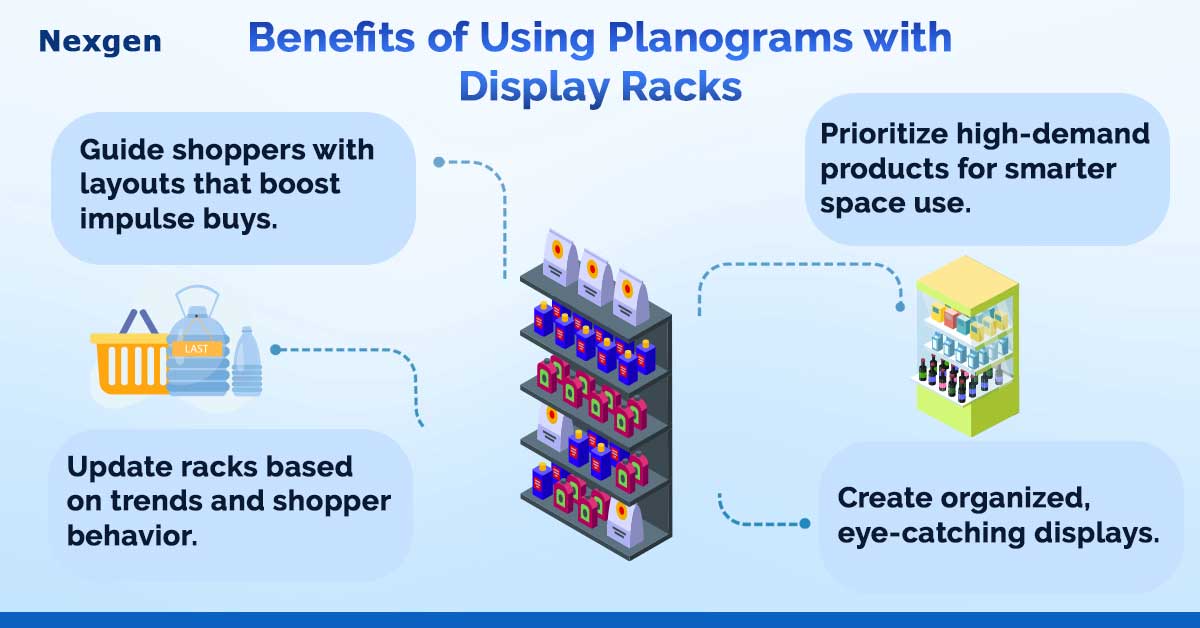In the competitive world of retail, effective product placement is key to driving sales and enhancing customer experience. Display racks, when utilized strategically with planogram solutions, can transform a store’s layout into a powerful sales engine. This blog explores how a planogram-driven approach to display racks can optimize space, influence shopper behavior, and ultimately boost revenue.
The Role of Display Racks in Retail
Display racks serve as the backbone of any retail setup. They not only hold products but also act as visual anchors that guide shoppers through the store. Their layout and design significantly impact how customers perceive and interact with the merchandise.
However, the true potential of display racks lies in their ability to:
- Maximize space utilization.
- Enhance product visibility.
- Create a seamless shopping experience.
By integrating planogram technology, retailers can unlock the full potential of display racks.
What Are Planograms?
Planograms are visual diagrams or schematics that map out the placement of products on shelves, racks, and other retail fixtures. These tools are designed to optimize shelf space while considering factors like product demand, profitability, and shopper behavior.
Planograms enable retailers to:
- Ensure consistent product placement across multiple stores.
- Maintain inventory accuracy.
- Leverage data-driven insights for better merchandising.
Benefits of Using Planograms with Display Racks
When paired with planograms, display racks become more than just storage solutions; they evolve into strategic sales tools. Here’s how:

- Optimized Space Allocation: Planograms allow retailers to allocate space based on product performance, ensuring that high-demand items are placed prominently while minimizing wasted shelf space.
- Improved Shopper Navigation: Planograms help create intuitive layouts that guide shoppers to key product categories. Grouping complementary items together on display racks can encourage impulse purchases and cross-selling.
- Enhanced Visual Appeal: A well-designed planogram ensures that products are displayed attractively, catching the shopper’s eye and increasing the likelihood of purchase.
- Data-Driven Decisions: By analyzing sales data, planograms can be adjusted to reflect trends, seasonal demands, and customer preferences, ensuring the display racks always remain relevant.
Implementing a Planogram-Driven Approach
To harness the benefits of planograms with display racks, follow these steps:
- Analyze Shopper Data: Use sales data and shopper insights to understand buying patterns and preferences. This information will inform the placement strategy.
- Design Effective Planograms: Create detailed planograms tailored to each display rack. Consider factors like product size, brand prominence, and shopper accessibility.
- Test and Iterate: Pilot the planograms in a few locations to gather feedback and measure performance. Use these insights to refine the design.
- Train Staff: Ensure store employees understand the planogram layout and its objectives. Proper implementation is critical for success.
- Monitor and Update: Continuously monitor the effectiveness of the planogram and make adjustments based on sales trends, inventory levels, and seasonal shifts.
Success Stories
Retailers worldwide have witnessed significant improvements by adopting planogram-driven display rack strategies. For instance, a grocery chain increased snack sales by 25% by reorganizing its display racks using data-driven planograms. Similarly, a fashion retailer saw a 15% rise in accessory sales by placing complementary items on adjacent racks.
Overview of Nexgen POG
Nexgen offers store-specific planograms for clients that optimize sales and achieve category objectives. We create customized planograms for your business to ensure that these are better aligned with your goals and merchandising strategies. Our expertise in planogram automation helps us build planograms faster, better, and consistently. Whether it is creating a planogram from scratch, or a typical reset, we have the knowledge, tools, and experience to get the job done for you.
Get Your Free Trial Today!